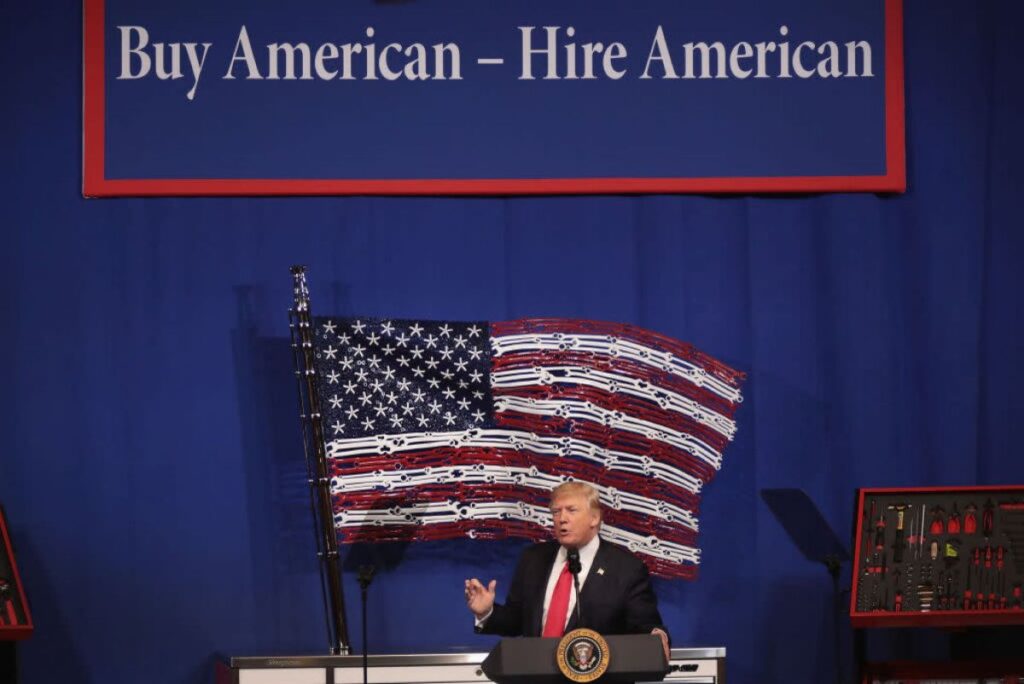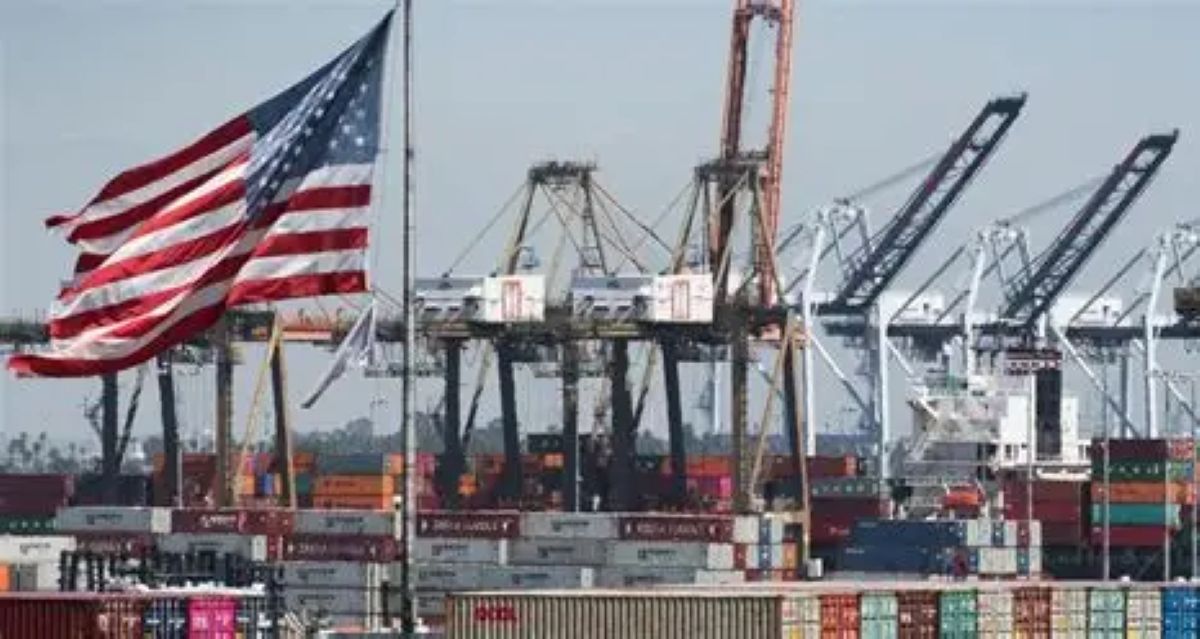
President Trump Agenda 47 Report is a comprehensive policy framework guiding his second term, focused on reshaping America with an America First approach. This report card evaluates progress made roughly 100 days into his administration across key areas such as trade, tax reform, immigration, energy, social policy, government reform, and foreign affairs. While some promises have seen visible action, many face legal, political, and economic challenges. This analysis reveals where Agenda 47 is advancing and where it may stall in the coming months.
Image Credit: Getty Images
Trump Agenda 47 Report Card: Key Promises & Progress Overview
| Promise Area | What Was Promised (in brief) | Status ≈ 100 Days into Trump’s Second Term | Notes / Challenges |
| Trade & Tariffs | 10–20% tariffs on North American allies; 60% on Chinese imports; “America First” trade deals | Partially done / underway | Some tariffs imposed; trade deals under discussion but none major secured yet. Legal and market pushback remains. |
| Tax Cuts / Tax Reform | Lower corporate tax rates; eliminate taxes on tips; make existing cuts permanent | In progress / partly stalled | Push to make prior cuts permanent ongoing; big-ticket items (like no tax on tips) delayed. Congress approval needed. |
| Immigration & Border | Mass deportations, stricter border control, finish wall, reinstate “Remain in Mexico,” end birthright citizenship | Underway / faces legal obstacles | Wall work restarted; some policies reinstated. Birthright citizenship blocked in courts; travel bans facing challenges. |
| Environment & Energy | Roll back climate rules, withdraw from climate pacts, expand oil & gas, cut renewables support | Mostly underway | Orders issued to roll back Biden-era rules; oil/gas boosted. But courts block parts, and international commitments still complex. |
| Wars / Foreign Policy | End wars, negotiate peace (Ukraine, Gaza, etc.) | Not delivered / broken so far | Wars continue; no breakthrough peace deal. Global instability persists. |
| Government Reform | Shrink bureaucracy, cut spending, reorganize agencies, reduce federal workforce, close Dept. of Education | In progress / partially realized | Staff cuts and reorg attempts started; Education Dept. still running; legal and operational pushback slowing progress. |
| Social Policy | Roll back protections (transgender rights), more state control over abortion & gender issues | Mostly underway | Executive orders rolling back protections; abortion laws pushed to states. Strong legal and social resistance. |
| Inflation / Economy | Bring down inflation, reduce costs, stimulate business/manufacturing, reduce deficits | Mixed / modest success so far | Inflation slightly down (trend started earlier); tariffs raise some costs; trade deficit still high; cautious investment climate. |
Introduction
President Donald Trump’s “Agenda 47” stands as the principal policy roadmap guiding his second term, representing a sweeping attempt to reshape U.S. government, economy, and society according to America First priorities. Rolled out during the 2024 campaign, Trump Agenda 47 Report encompasses a wide-ranging set of proposals—spanning immigration reform, tough border enforcement, new trade and tariff regimes, tax reduction, and major overhauls to federal governance and education.
This analysis delves into the first 100 days since President Trump returned to office, delivering a clear-eyed assessment of progress across the critical pillars of his policy agenda. Each section breaks down not only what has been attempted, but also what remains aspirational or faces significant legislative and legal resistance.
As the Trump administration embarks on this ambitious course, Americans and political observers alike are scrutinizing whether the promises of Agenda 47 are rapidly materializing into policy reality—or encountering the enduring frictions of Washington. The 100-day mark serves as an essential milestone, offering early insight into which initiatives are taking hold and where the biggest challenges to implementation are emerging.
Trade & Tariffs
President Trump’s second-term agenda has brought a dramatic escalation in tariff policies, fulfilling campaign promises to impose heavy duties on imports from North American allies and China. Executive orders early in 2025 instated 25% tariffs on nearly all goods from Canada and Mexico, exempting specific energy exports at a reduced 10% rate.
Tariffs on Chinese goods were also raised to between 10–20%, with some categories and reciprocal actions driving rates even higher. Additionally, the White House authorized individualized “reciprocal” tariffs aimed at countries with significant trade barriers against the United States. These moves used emergency powers to circumvent previous agreements.
Despite these forceful actions, the administration has not yet secured any major new trade agreements. The early months have exposed substantial resistance from U.S. businesses, foreign governments, and international markets.
Canada and Mexico have responded with retaliatory tariffs, starting a trade war that has unsettled supply chains and increased consumer costs. Moreover, the legal framework for these tariffs is being contested in federal courts. Although rulings have allowed temporary continuation, the long-term viability remains uncertain.
The initial “America First” trade agenda shows tangible progress but faces disruptive economic and diplomatic challenges.
In line with the America First agenda, the administration has imposed significant tariffs on imports from North American allies and China. For a deeper analysis of how Trump’s America First policy is reshaping global relations and trade, see our detailed report on Trump America First Policy and The Global Consequences.
Trump’s protectionist trade policies have reshaped global alliances and caused significant economic repercussions. For a comprehensive analysis, see Trump’s America First Agenda: The Repercussions of Alienating Key Trade Alliances.
Taxes & Tax Cuts
President Trump promised significant tax relief focused on lowering corporate tax rates, making prior tax cuts permanent, and eliminating taxes on tips. His agenda aimed to solidify the gains from the 2017 Tax Cuts and Jobs Act (TCJA), which had temporarily reduced corporate taxes from 35% to 21% and introduced various other tax relief measures.
As of 100 days into his second term, progress on these tax priorities is ongoing but has encountered delays. Congressional debates have stalled comprehensive legislation to make all tax cuts permanent, including the contentious proposal to exempt tips from federal taxation.
Despite bipartisan discussions, the push to extend tax relief to businesses and individuals is a complex negotiation, with concerns about the fiscal impact of permanent tax cuts. The administration is continuing efforts to advance key pieces around corporate tax certainty and reduced taxation for certain income types, but some measures face both political and public resistance.
In summary, the tax agenda is actively pursued but awaits Congressional approval to become fully realized, reflecting the challenging environment for major fiscal reforms.
Immigration & Border Security
President Trump promised an aggressive crackdown on immigration, including mass deportations, completing the border wall, reinstating strict asylum policies, and ending birthright citizenship.
Work on the border wall has restarted with new contracts awarded to erect barriers, mainly along strategic sections. This follows a significant increase in border enforcement funding and deployment of military personnel to support border security operations.
Stricter asylum rules have been reinstated, severely limiting eligibility and expanding expedited removal processes. These policies aim to reduce unauthorized entries but have faced criticism from advocates concerned about humanitarian impacts.
The administration’s efforts to end birthright citizenship have been blocked by courts so far, with legal challenges pending. Major logistical and legal hurdles slow some initiatives, but the administration’s firm focus on immigration enforcement remains clear.
Despite operational progress, the immigration agenda encounters significant resistance both legally and diplomatically, underscoring the complex challenges of this policy area.
Environment & Energy
President Trump’s Agenda 47 pledged a robust expansion of fossil fuel production, a rollback of environmental regulations, and a withdrawal from international climate accords. Early in his second term, the administration acted quickly to fulfill these promises.
Through executive orders, Trump has prioritized boosting oil, natural gas, and coal production. Permitting processes have been expedited, and federal agencies have been directed to reduce regulations that were put in place to limit fossil fuel development.
The administration declared a national energy emergency to facilitate increased leasing and extraction of fossil fuels on federal lands. It has also rolled back funding for renewable energy programs initiated under the previous administration, particularly targeting wind and solar projects.
However, these aggressive moves have sparked lawsuits from environmental groups, challenging the legality of many rollbacks. Internationally, the U.S. faces pressure to remain a participant in climate commitments, complicating efforts to fully pull back from global agreements.
Overall, while fossil fuel expansion is largely underway, legal challenges and global climate dynamics continue to complicate the administration’s energy agenda.
Wars & Foreign Policy
President Trump promised to end America’s involvement in foreign wars and broker peace in conflict zones such as Ukraine and Gaza. His agenda emphasized reducing the U.S. military footprint abroad and pushing for negotiated settlements to long-standing conflicts.
However, roughly 100 days into his second term, these promises remain largely unfulfilled. Wars continue unabated in key hotspots, with little tangible progress toward diplomatic resolutions. The conflict in Ukraine, in particular, sees ongoing violence despite diplomatic efforts.
Critics highlight a stalled diplomatic front and a lack of major foreign policy achievements as key weaknesses of the administration’s approach. While some regional tensions have seen temporary easing, a comprehensive win on the international peace stage has not yet materialized.
The administration faces significant challenges in balancing military disengagement goals with the complex realities on the ground in global conflict zones. This has drawn criticism from allies and opponents alike over perceived setbacks in U.S. leadership and stability efforts abroad.
Government Reform
President Trump pledged to shrink the federal government by cutting spending, reorganizing agencies, and ultimately closing the Department of Education. This bold promise aimed to reduce bureaucracy and streamline government operations.
Since taking office, the administration has initiated some workforce cuts and restructuring efforts across various federal agencies. An executive order stripped thousands of federal employees of certain job protections, allowing for easier layoffs and firings.
However, the Department of Education remains fully operational and has not been closed. Legal challenges and pushback from agencies and courts have slowed the dismantling process, creating significant obstacles.
The administration’s workforce reduction efforts have led to tens of thousands of federal employee departures, either through buyouts or resignations. Yet, judicial rulings have blocked or delayed some mass layoffs, underscoring the legal complexities involved.
Overall, while the drive to shrink government shows visible signs of progress, institutional resistance and legal hurdles continue to impede the full realization of this promise.
Social Policy
President Trump’s Agenda 47 promised to roll back protections for transgender rights and shift abortion regulation more prominently to the states. Within days of his second inauguration, the administration moved swiftly to fulfill these pledges through executive orders.
The administration issued Executive Order 14168, which redefined sex at the federal level as strictly biological and immutable, effectively rescinding federal recognition of transgender identities. This order ended gender-affirming care coverage for youth in federally funded programs and restricted transgender individuals’ use of facilities matching their gender identity.
Abortion rights have been pushed back toward state-level regulation, with federal guidance realigned to allow states broader authority to set policies. This move has intensified legal and political battles across different states, where abortion access continues to vary widely.
These actions have met heavy social resistance and numerous legal challenges. Advocacy groups have filed lawsuits against the administration’s rollback of transgender protections, and court rulings have temporarily blocked some provisions.
Despite the pushback, the administration remains committed to reshaping social policy along conservative lines, focusing on what it calls “protecting biological truth” and “returning authority to states.”
Inflation & Economy
President Trump promised to lower inflation, reduce federal deficits, and boost U.S. manufacturing as key pillars of his economic agenda. These goals aim to restore economic stability and strengthen domestic industry.
The status of these promises is mixed. Inflation has edged slightly downward in line with long-term trends, but recent broad tariffs have contributed to higher prices on many consumer goods. For example, tariffs on steel, electronics, and other imports have driven up costs that businesses often pass to consumers.
The trade deficit remains stubbornly high despite ongoing efforts to rebalance trade relationships. Manufacturing growth has seen modest improvements but faces headwinds from supply chain disruptions and tariff-related expenses.
Overall, while inflation shows some signs of moderation, economic challenges remain, reflecting the complexity of achieving rapid improvements in these areas.
Conclusion
Assessing the overall progress of President Trump’s Agenda 47 at the 100-day mark reveals a mixed picture. Tangible advances have been made in areas such as immigration enforcement, fossil fuel expansion, and social policy rollbacks—reflecting the administration’s ability to issue executive orders and direct agencies swiftly.
However, significant obstacles remain. Legal challenges have slowed or blocked key initiatives involving birthright citizenship, government reform, and climate policy rollbacks. Diplomatic efforts to end foreign wars and broker peace have yet to yield meaningful results. Economic factors, including tariffs and trade deficits, continue to present complex hurdles.
The coming 6 to 12 months will be pivotal in determining whether Agenda 47 can convert its early momentum into sustained policy victories or if entrenched legal, political, and economic realities will cause critical components of the agenda to stall completely. Close attention to Congressional actions, court rulings, and international developments will reveal the ultimate trajectory of the administration’s ambitious agenda.


Leave a Reply